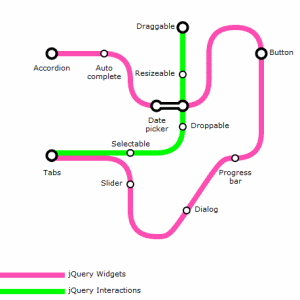I have always admired subway maps for the clarity and elegance with which they are able represent a convoluted public transport system. Now there is a way to expand this concept and create your own maps using a subway map plugin for jQuery written by Nik Kalyani.
This plugin allows you to specify the data for drawing the map, and makes the concept of the subway map entensible to represent anything you would like. In fact, I recently saw one detailing the progression of modern rock music, with the different lines representing different musical genres as a timeline, and major bands representing “stations”.

Sample subway map from Nik's demo
For a detailed tutorial of how to use this plugin, go read the original post by Nik Kalyani on his blog.